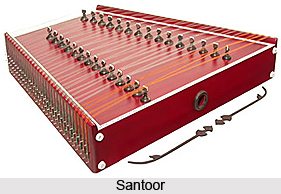 Most of the instruments used in Indian Classical Music were invented during mid 19th century. A variety of instruments accompany the Indian classical music. Indian classical music is one of the most ancient traditions of the country. Over years many instruments have developed and have also gone numerous modifications. With the advent of various musical instruments, music concerts and recordings have become more popular and charming.
Most of the instruments used in Indian Classical Music were invented during mid 19th century. A variety of instruments accompany the Indian classical music. Indian classical music is one of the most ancient traditions of the country. Over years many instruments have developed and have also gone numerous modifications. With the advent of various musical instruments, music concerts and recordings have become more popular and charming.
Veena
Veena is a category of plucked string instruments. The strings, hollow neck, bridge design and gourd resonating chamber creates enchanting melodies in Veena. Teak wood or tun wood is used to make the gourds and neck of the Veena whereas the bridges of the instrument are composed of ebony, deer horn or occasionally of camel bone. Nowadays synthetic materials are also used. Mention of Veena in the ancient texts confirms its existence since ages. It has also undergone many changes and modifications over years. In ancient times, the historians have the proof of existence of Veena, when they found the coins during the period of Samudragupta.
Sarod
Sarod is another stringed instrument of India and forms an important part of Indian classical music. Sitar produces a deep and introspective sound that has the capability to stir the emotions of the audiences. Sarod is derived from an ancient musical instrument known as Afghan rubab, of Afghanistan. Amjad Ali Khan and Allauddin Khan are considered as the epitome of Sarod in India. Playing of Sarod requires specific fingering techniques in which strings are pressed hard against the fingerboard.
Shehnai
Shehnai is another popular instrument used extensively in Indian classical music. It is a wind instrument and is common in northern and western India. Shehnai is a tube like instrument composed of wood which ends with a metal flare bell. The sound produced by Shehnai creates a sense of auspiciousness and is thus widely used in marriages. Shehnai covers a range of two octaves. Famous exponents of Shehnai in India are Ustad Bismillah Khan, Pt. Rajendra Prasanna and Ali Hussain Khan.
 Flute
Flute
Another wind instrument used in Indian classical music is flute. Flutes are one of the oldest musical instruments of India. Melodies are produced in flute by directing a stream of air across the holes in the instruments. The angle and velocity of directing the air should be correct to produce the appropriate sound. In India, bamboo is the prime raw material used for making flute. According to Indian mythology, Lord Krishna is considered as the master of flute. Two categories of flutes are found in India namely Bansuri and Venu. The quality of sound produced by the flute depends on the type of bamboo used and the best variety is said to be found in South India.
Santoor
Santoor is a string instrument used in the classical music. Indian Santoor is a rectangular shaped instrument composed of walnut or maple wood having more than seventy two strings. A Santoor covers a range of three octaves. In ancient times, Santoor was extensively used in the folk music of Kashmir. Efficient playing of Santoor requires special techniques and is played by sitting in Ardha padmasana posture. Santoor is highly sensitive to mild strokes and glides and is a very delicate instrument. Santoor maestros of India are Pt. Shiv Kumar Sharma, Tarun Bhattacharya, Bhajan Sopori, Rahul Sharma etc.
Tabla
Tabla is a percussion instrument which is widely used along with Hindustani classical music and devotional songs. Tabla consists of a pair of hand drums of different shapes and sizes. The sounds produced by the two drums also differ vastly. Technique of playing Tabla includes use of palms and fingers in different ways to produce different types of sounds. The invention of Tabla dates back to 13th century by a musical maestro Amir Khusro who was also a Sufi poet. The most distinguished name in the world of Tabla players are Ahmed Jan Thirakwa, Alla Rakha Khan and Zakir Hussain.
Pakhavaj
Pakhavaj is percussion instrument which is a two headed drum having a barrel shape. It is a variant and modified form of another ancient instrument called mridangam. Similar to Tabla, rhythms are produced by Pakhavaj by following a set of mnemonic syllables also known as bol. It is played by placing it horizontally over a cushion in front of the player`s crossed leg. The smaller treble skin of the Pakhavaj is played by the right hand whereas the large bass skin with left hand. Renowned Pakhavaj players of India are Durga Lal and Mahapurush Misra.
Esraj
Esraj is a string instrument found extensively in northern, eastern and central regions of India. It is comparatively a young instrument, being just 200 years old. Two forms of this instrument are found known as dilruba and Esraj. Dilruba is prevalent in the north India and accompanies light classical and religious music. Esraj is more popular in East and Central India and accompanies greater styles of music than dilruba. Prominent Esraj players of India include A.R. Rahman, Pandit Ranadhir Ray, Buddhadeb Das etc.
Classical music is one of the oldest traditions of India. It has enriched the culture of the country in most vivid manner. Various Instruments used in Classical Music add vigour to this age old tradition of India popularizing it even more.




















